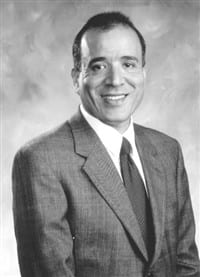Building Business Partnerships STCC Project Works To Identify Needs Of Regional ‘Clusters, ’ Including In Health
Geoff Little says area employers have been asked many times — and in many ways — to project into the future, assess where their specific sectors are going, and gauge what skills their employees will need.
“People tell us that they keep being asked, ‘what do you need? What do you need? What do you need?” said Little, adding that what has been missing from the equation in many ways has been adequate response to the answers from those queries.
Providing timely, appropriate response is one of the many goals behind an ambitious undertaking on the part of Springfield Technical Community College. The Business Partnership Development Program, as it’s called, is designed to garner specific information about where several area business ‘clusters’ are headed in terms of everything from foreign competition to needed employee skill sets, said Little, the project’s leader, who has recently served as a consultant on a number of regional economic development initiatives.
He told The Healthcare News the business partnership project has involved the hiring of the Utah-based Clements Group, which specializes in mentoring clients, including 500 community colleges nationwide, to envision, analyze, and quantify needs, analyze funding sources, and then develop strategies for meeting stated goals. The initiative is being undertaken in response to outlined priorities contained within the region’s Plan for Progress, which was updated last year, and it was also inspired by President Bush’s call last year for the nation’s community colleges to take on a larger role in workforce development initiatives.
“Federal money will soon become available for specific projects that fall in this realm,” said Gail Carberry, the school’s vice president of Grants and Development. With information gleaned from the business partnership, the college should be better positioned to win some of that funding, she added.
And information is now starting to come in.
Representatives of several clusters have come together for forums at the college over the past few months. These groups include hospitals (14 representatives of area facilities, including Hank Porten, president and CEO of Holyoke Medical Center, and Charles Cavagnaro, president and CEO of Wing Memorial Hospital were in attendance) and two sessions of manufacturers — those with fewer than 100 employees and those above that number.
Data and comments are being organized into comprehensive reports, said Little, noting that this is only the first step in the process. What follows is work to prioritize identified needs and develop strategies to meet them. Steps could run the gamut, he said, from minor curriculum adjustments to expansion of existing academic offerings to creation of new programs.
What happens, and how soon, will be a function of priority and resources, said Carberry, noting that STCC President, Ira Rubenzahl, who took office last summer, made it one of his priorities to collaborate with area businesses to ensure that the workforce of the future was adequately equipped with the skills it would need.
Work in Progress
Referring to the project’s name, Little, a member of the Executive Committee of the STCC Foundation board, which agreed to split the $18,000 cost of the project, said the word to focus on is partnership. He told The Healthcare News that the process of assessing needs and crafting responses will be ongoing, with information-gathering sessions occurring perhaps on an annual basis with some clusters.
The goal is to generate a running community-wide dialogue that with help the school — and perhaps other area colleges as well — more effectively anticipate and then meet the broad and specific needs of area companies and industry groups.
STCC is focusing on those sectors in which it specializes — primarily health care, manufacturing, and engineering technology, among others. The school has advisory boards that work to identify industry needs and curriculum priorities, Little explained, but these groups operate in what he called “real time.”
What the college needed was a format that would project needs further into the future, and for that, it turned to the Clements Group. The 20-year-old company works primarily with community colleges and technical institutes, although it also provides assistance in resource development for K-12 systems and related foundations.
For colleges, the Clements Group offers an array of services, including strategic planning, institutional development assessment, fundraising campaigns, image and marketing services, feasibility studies, and foundation board organization and training. STCC’s specific need was a format that would enable it to qualify and especially quantify responses from representatives of several area clusters.
The methodology, said Little, involves both individual answers and group feedback on questions designed to identify ways in which the college’s academic programs, career services, and corporate and professional programs could better serve local businesses and agencies. Little said the Clements Group is essentially providing an infrastructure for ongoing assessment.
The forums differ from many of the school’s advisory boards in that they involve industry leaders, said Little, those who are living the present and have insight into the future.
In addition to Porten and Cavagnaro, the hospital forum included human resources managers and other administrators from several area providers, including Baystate Health System, the Sisters of Providence Health System, Hartford Hospital, Shriners Hospital, Berkshire Medical Center, Monson Developmental Center, and many others.
Assessing the first few forums, Little and Carberry said they have been informative and valuable, and with responses that range from the predicted to the unexpected.
“We heard about a need for more keyboarding skills for nurses,” said Carberry, referring to a need that fell in the latter category. That point reflects the growing use of laptop computers and PDAs by nurses, doctors, and technicians to enter patient information and for other uses, she said, adding that it was one of many topics raised during the forum.
Porten told The Healthcare News that he found the roundtable for hospital administrators to be a worthwhile exercise, one that provided organizers some material for discussion. He said the general focus was on the future of health care, the specific needs of providers, and gaps in training and education that could be filled.
There was considerable discussion about the ongoing nursing shortage, he said, adding that he also referenced a looming physician shortage, which may have even more dire consequences for the state’s hospitals.
Porten said he told forum organizers that he would like to see more focus, in general, on clinical decision-making in the training of nurses and many technicians. He told The Healthcare News that the medical center puts such employees though a training session — lasting one to three months — before they can actually see a patient and administer care.
With more clinical experience at the college level, Holyoke and other hospitals that have similar regimens may be able to reduce that orientation period, thus saving money in the long run.
The input from Porten and the others at the hospital forum is being digested, said Carberry, adding that a preliminary report will be sent to attendees. “It will say, in essence, ‘this is what we thought we heard you say,’” she said, adding that participants will be asked to corroborate those findings and offer additional input. The gathered thoughts and follow-up will eventually shape a final report.
When reports from other clusters are completed, the college will then move on to the next step — establishing priorities and crafting responses. Other forums are scheduled for the next several months, she said, and they include the financial services sector, transportation, and K-12 education.
On-the-Jobs Training
Carberry told The Healthcare News that if STCC expects to win some of the federal money to be made available to community colleges for workforce development initiatives, it will need both data and partners.
The ongoing project is designed to provide both, she said.
“This process will enable us to be more proactive, rather than reactive to the needs of businesses,” she explained. “We’ve seen a ton of energy come out of the first forums … we want to take that energy and use it to strengthen all these clusters.”





Comments are closed.